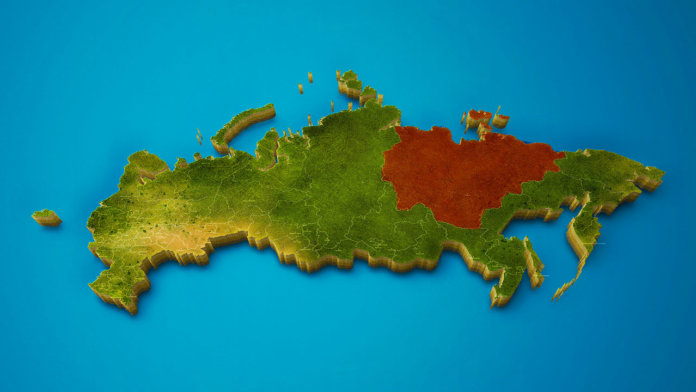As we all know from the course of geography, the Russian Federation is the largest country in the world in terms of area (17425.2 thousand km2, 85 subjects). Many territorial units of our state, in turn, are larger than some world countries. What are the sizes of the largest regions in Russia - subjects of the Russian Federation in terms of area - we will describe below.
| # | Subject of Russia | Area, km² | % of RF |
|---|---|---|---|
| 1 | The Republic of Sakha (Yakutia) | 3083523 | 18.01 |
| 2 | Krasnoyarsk region | 2366797 | 13.82 |
| Tyumen region with Khanty-Mansiysk and Yamal | 1464173 | 8.55 | |
| 3 | Khabarovsk region | 787633 | 4.6 |
| 4 | Irkutsk region | 774846 | 4.52 |
| 5 | YaNAO | 769250 | 4.49 |
| 6 | Chukotka Autonomous District | 721481 | 4.21 |
| Arkhangelsk region including NAO | 589913 | 3.44 | |
| 7 | KhMAO - Ugra | 534801 | 3.12 |
| 8 | Kamchatka Krai | 464275 | 2.71 |
| 9 | Magadan Region | 462464 | 2.7 |
| 10 | Zabaykalsky Krai | 431892 | 2.52 |
| 11 | Komi Republic | 416774 | 2.43 |
| 12 | Arkhangelsk region without NAO | 413103 | 2.41 |
| 13 | Amur region | 361908 | 2.11 |
| 14 | The Republic of Buryatia | 351334 | 2.05 |
| 15 | Tomsk region | 314391 | 1.84 |
| 16 | Sverdlovsk region | 194307 | 1.13 |
| 17 | Republic of Karelia | 180520 | 1.05 |
| 18 | Novosibirsk region | 177756 | 1.04 |
| 19 | Nenets Autonomous Okrug | 176810 | 1.03 |
| 20 | Tyva Republic | 168604 | 0.98 |
| 21 | Altai region | 167996 | 0.98 |
| 22 | Primorsky Krai | 164673 | 0.96 |
| 23 | Perm region | 160236 | 0.94 |
| 24 | Tyumen region without Khanty-Mansiysk and Yamal | 160122 | 0.94 |
| 25 | Murmansk region | 144902 | 0.85 |
| 26 | Vologda Region | 144527 | 0.84 |
| 27 | Republic of Bashkortostan | 142947 | 0.83 |
| 28 | Omsk region | 141140 | 0.82 |
| 29 | Orenburg region | 123702 | 0.72 |
| 30 | Kirov region | 120374 | 0.7 |
| 31 | Volgograd region | 112877 | 0.66 |
| 32 | Saratov region | 101240 | 0.59 |
| 33 | Rostov region | 100967 | 0.59 |
| 34 | Kemerovo region | 95725 | 0.56 |
| 35 | Altai Republic | 92903 | 0.54 |
| 36 | Chelyabinsk region | 88529 | 0.52 |
| 37 | Sakhalin Region | 87101 | 0.51 |
| 38 | Tver region | 84201 | 0.49 |
| 39 | Leningrad region | 83908 | 0.49 |
| 40 | Nizhny Novgorod Region | 76624 | 0.45 |
| 41 | Krasnodar region | 75485 | 0.44 |
| 42 | Republic of Kalmykia | 74731 | 0.44 |
| 43 | Kurgan region | 71488 | 0.42 |
| 44 | Republic of Tatarstan | 67847 | 0.4 |
| 45 | Stavropol region | 66160 | 0.39 |
| 46 | The Republic of Khakassia | 61569 | 0.36 |
| 47 | Kostroma region | 60211 | 0.35 |
| 48 | Pskov region | 55399 | 0.32 |
| 49 | Novgorod region | 54501 | 0.32 |
| 50 | Samara Region | 53565 | 0.31 |
| 51 | Voronezh region | 52216 | 0.3 |
| 52 | The Republic of Dagestan | 50270 | 0.29 |
| 53 | Smolensk region | 49779 | 0.29 |
| 54 | Astrakhan region | 49024 | 0.29 |
| 55 | Moscow region | 44329 | 0.26 |
| 56 | Penza region | 43352 | 0.25 |
| 57 | Udmurtia | 42061 | 0.25 |
| 58 | Ryazan Oblast | 39605 | 0.23 |
| 59 | Ulyanovsk region | 37181 | 0.22 |
| 60 | Jewish Autonomous Region | 36271 | 0.21 |
| 61 | Yaroslavskaya oblast | 36177 | 0.21 |
| 62 | Bryansk region | 34857 | 0.2 |
| 63 | Tambov Region | 34462 | 0.2 |
| 64 | Kursk region | 29997 | 0.18 |
| 65 | Kaluga region | 29777 | 0.17 |
| 66 | Vladimir region | 29084 | 0.17 |
| 67 | Belgorod region | 27134 | 0.16 |
| 68 | The Republic of Mordovia | 26128 | 0.15 |
| 69 | Republic of Crimea | 26081 | 0.15 |
| 70 | Tula region | 25679 | 0.15 |
| 71 | Oryol Region | 24652 | 0.14 |
| 72 | Lipetsk region | 24047 | 0.14 |
| 73 | Mari El Republic | 23375 | 0.14 |
| 74 | Ivanovo region | 21437 | 0.13 |
| 75 | Chuvash Republic | 18343 | 0.11 |
| 76 | Chechen Republic | 16165 | 0.09 |
| 77 | Kaliningrad region | 15125 | 0.09 |
| 78 | Karachay-Cherkessia | 14277 | 0.08 |
| 79 | Kabardino-Balkaria | 12470 | 0.07 |
| 80 | Republic of North Ossetia - Alania | 7987 | 0.05 |
| 81 | Republic of Adygea | 7792 | 0.05 |
| 82 | The Republic of Ingushetia | 3628 | 0.02 |
| 83 | Moscow | 2561 | 0.01 |
| 84 | St. Petersburg | 1403 | 0.01 |
| 85 | Sevastopol | 864 | 0.01 |
10. Kamchatka Territory, S = 464,275 km²
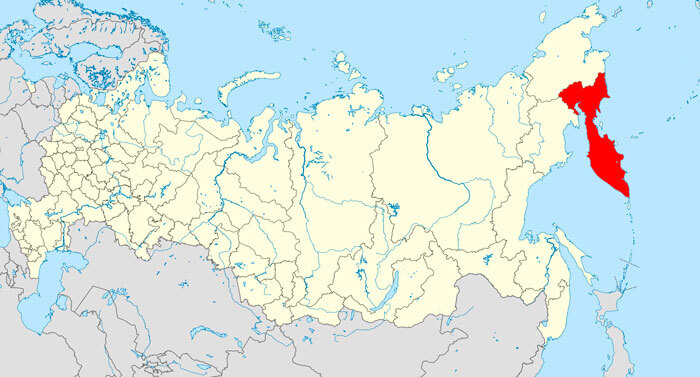 It is located in the northeast of the country, on the Kamchatka Peninsula (Far Eastern Federal District), washed by the waters of the Pacific Ocean, as well as the Okhotsk and Bering Seas. One of the most beautiful regions of Russia - there is a valley of geysers with thermal and mineral springs, and active volcanoes (there are about 30 of them). All of the above, together with the combination of the natural unspoiled beauty of the tundra and alpine meadows, makes this area a popular tourist destination.
It is located in the northeast of the country, on the Kamchatka Peninsula (Far Eastern Federal District), washed by the waters of the Pacific Ocean, as well as the Okhotsk and Bering Seas. One of the most beautiful regions of Russia - there is a valley of geysers with thermal and mineral springs, and active volcanoes (there are about 30 of them). All of the above, together with the combination of the natural unspoiled beauty of the tundra and alpine meadows, makes this area a popular tourist destination.
The Kamchatka Peninsula is sparsely populated - only about 315 thousand people live on a large area.man - this is largely due to unfavorable, unstable natural conditions. Perhaps that is why the ecological situation in Kamchatka is one of the most favorable in the Russian Federation.
The region occupies a leading position among other regions of Russia in terms of the production of precious metals (gold and platinum), and is distinguished by the richest marine biological resources (industrial catching of commercial fish, seafood, Kamchatka crabs has been established on the peninsula).
For comparison: the Kamchatka Territory is larger in area than England, Belgium, Portugal and Luxembourg.
9. KhMAO - Yugra, S = 534 800 km²
 The region is located in the central part of the West Siberian Plain (part of the Ural Federal District); rich in water resources, taiga forests, large navigable rivers (Ob, Irtysh). In this region is the highest point of the Ural ridge - Mount Narodnaya (1895 m). The territory, although vast, is sparsely populated (density 3.1 people per sq. Km). The indigenous population - Khanty and Mansi - make up only 2% of the total number of ethnic groups.
The region is located in the central part of the West Siberian Plain (part of the Ural Federal District); rich in water resources, taiga forests, large navigable rivers (Ob, Irtysh). In this region is the highest point of the Ural ridge - Mount Narodnaya (1895 m). The territory, although vast, is sparsely populated (density 3.1 people per sq. Km). The indigenous population - Khanty and Mansi - make up only 2% of the total number of ethnic groups.
Oil and gas are mined in the Okrug - Khanty-Mansi Autonomous Okrug is the largest supplier of "black gold" in the Russian Federation, therefore the main specialization of industrial enterprises is servicing the oil and gas industry. A logging complex is also developed.
All this allowed the region to become one of the best in the country in terms of quality of life.
Due to the favorable economic situation, the population of Ugra is steadily increasing: 1 558 thousand people were recorded in 2012, 1 626.8 thousand people. - in 2016.
8. Arkhangelsk region, S = 589,913 km²
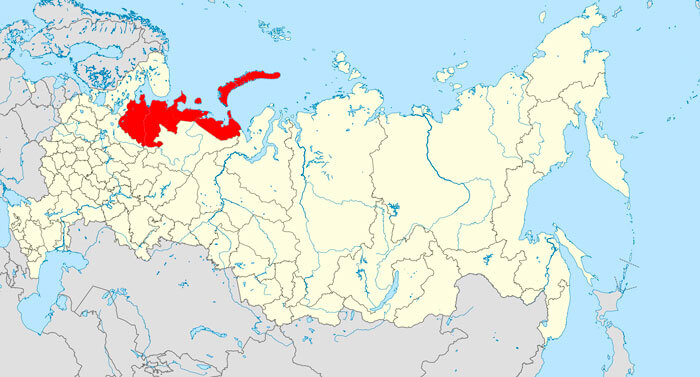 The subject is located in the north-west of the country, part of the land belongs to the regions of the Far North. The region, which among other Russian subjects is the leader in terms of the total area of the islands (104.4 thousand sq. Km), includes the Franz Josef Land and Novaya Zemlya Archipelagoes. There is also the extreme northern point of Russia, Europe and the entire continent - Cape Fligeli. It is washed by the northern seas - White, Barents and Kara. In size it exceeds the territory of France, Spain, Madagascar.
The subject is located in the north-west of the country, part of the land belongs to the regions of the Far North. The region, which among other Russian subjects is the leader in terms of the total area of the islands (104.4 thousand sq. Km), includes the Franz Josef Land and Novaya Zemlya Archipelagoes. There is also the extreme northern point of Russia, Europe and the entire continent - Cape Fligeli. It is washed by the northern seas - White, Barents and Kara. In size it exceeds the territory of France, Spain, Madagascar.
The region is fabulously rich in natural resources: an abundance of oil, gas, timber, diamonds, bauxite, gypsum, gold and other metals - makes this region one of the key regions for mining in Russia, and the wild beauty of the northern lands and thousands of lakes - one of the most beautiful.
A.O. - industrial region: on the territory of the constituent entity of the Russian Federation there is the Plesetsk cosmodrome, as well as enterprises of the military-industrial complex in Severodvinsk (production of nuclear boats), the production of cellulose, timber, shipbuilding and the fishing industry is well developed. The population is 1,155,028 people (as of 01.01.2018).
7. Chukotka Autonomous District, area 721,481 km²
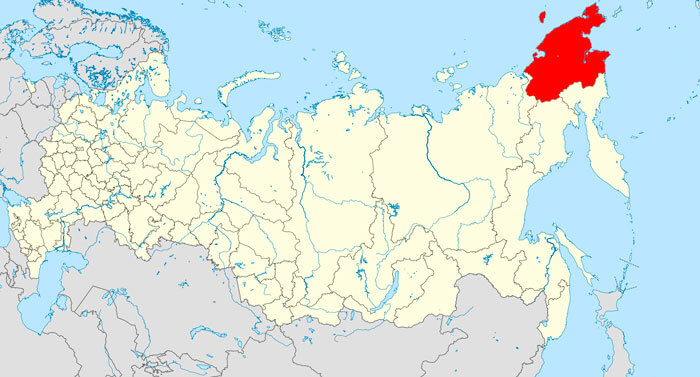 The most sparsely populated subject (population density is only 0.07 people / km²), the number of residents is 49 348 people. (as of January 1, 2018).
The most sparsely populated subject (population density is only 0.07 people / km²), the number of residents is 49 348 people. (as of January 1, 2018).
Geographically located in the extreme north-east of the Russian Federation, on the shores of the Arctic Ocean and partly the Pacific. The Autonomous Okrug is located on the Chukotka Peninsula, small islands and part of the mainland, and belongs to the Far Eastern Federal District. The border with the United States runs along the Bering Sea.
Due to its difficult geographical position (half beyond the Arctic Circle) it combines subarctic, maritime and continental climate. Winter here lasts 10 months a year. The basis of life of indigenous peoples (Chukchi - 25%, Eskimos - 3%) - reindeer husbandry, hunting and fishing.
Large deposits of gold, arsenic, silver, tin, and mercury were found in the depths of the Chukotka Autonomous Okrug.
6. Yamalo-Nenets Autonomous District, S = 769 250 km²
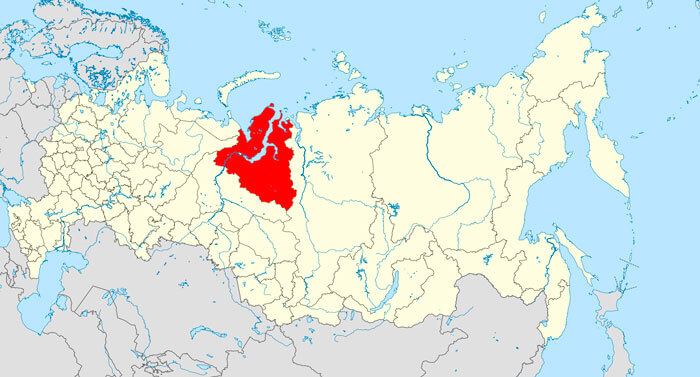 The largest autonomous region of Russia in translation from the Nenets language is the Land of the Earth. Located in the northwest of the Asian part of Russia. Occupies one of the largest plains - West Siberian. The capital of the district - Salekhard - is located on the Arctic Circle - half of the city is already located in the Arctic. A significant part of the territory is the Yamal Peninsula.
The largest autonomous region of Russia in translation from the Nenets language is the Land of the Earth. Located in the northwest of the Asian part of Russia. Occupies one of the largest plains - West Siberian. The capital of the district - Salekhard - is located on the Arctic Circle - half of the city is already located in the Arctic. A significant part of the territory is the Yamal Peninsula.
Since ancient times, the district has been a supplier of fish, furs and venison.The main income of the region is now formed from the sale of extracted oil, gas, venison and fish. In terms of combustible gas reserves, this region takes 1st place, and in terms of oil reserves - the second, it is also rich in other minerals, such as manganese, chromium, copper, pigs, cobalt, nickel, etc.
The population is only 538,547 people (according to 2018), according to experts, the demographic situation in Russia as a whole is not bad here due to the influx of young people and the dynamic development of the gas industry.
5. Irkutsk region, S = 774 846 km²
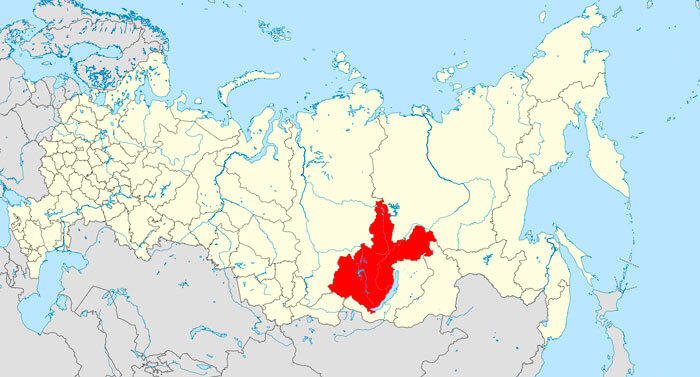 The region is located in the south of Eastern Siberia. The main attraction is Lake Baikal. The largest rivers on the geographical map of our vast homeland flow through the Irkutsk region - Angara, Lena, Yenisei, and the main attraction of the region is Lake Baikal.
The region is located in the south of Eastern Siberia. The main attraction is Lake Baikal. The largest rivers on the geographical map of our vast homeland flow through the Irkutsk region - Angara, Lena, Yenisei, and the main attraction of the region is Lake Baikal.
Among other Russian territorial units, the Irkutsk region is also considered "rich" land - gold (Lensky gold-bearing region), iron, coal, iron ore, hydrocarbons, manganese ores, rare metals are mined here - in general, a large number of minerals. The nature of the region is also rich in its forests - 11.5% of all forests in Russia are concentrated here.
The territory is part of the East Siberian economic region. The main industrial sectors are mining of useful resources, power generation, mechanical engineering (construction of Su-30 aircraft), production of cellulose and wood. For the extraction of furs (furs), the region occupies a leading position in the Russian Federation.
As of January 1, 2018, 2,404,195 residents were recorded.
4. Khabarovsk Territory, S = 787 633 km²
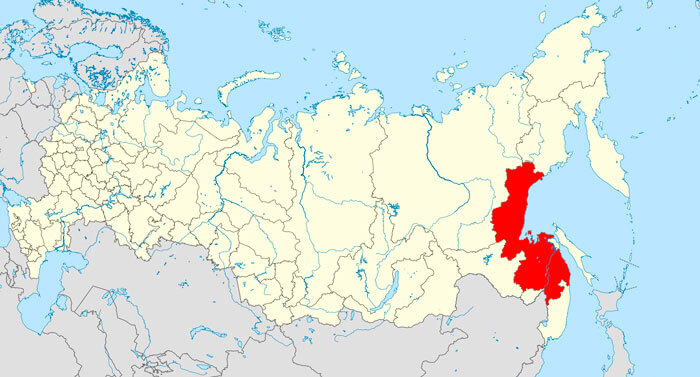 It occupies the central part of the Far East, from the east it is washed by the Okhotsk and Japanese seas. The southwestern borders run along the state border with China. Due to the large extent of the land and the elongated shape, there is a varied climate and relief: from tundra and taiga to the Sikhote-Alin mountain ranges. Mountains occupy about 80% of the entire territory. Here you can meet the Amur tiger, snow leopard, brown bear or leatherback turtle, and in the largest Far Eastern river Amur there are rare fish species, for example, the Amur sturgeon.
It occupies the central part of the Far East, from the east it is washed by the Okhotsk and Japanese seas. The southwestern borders run along the state border with China. Due to the large extent of the land and the elongated shape, there is a varied climate and relief: from tundra and taiga to the Sikhote-Alin mountain ranges. Mountains occupy about 80% of the entire territory. Here you can meet the Amur tiger, snow leopard, brown bear or leatherback turtle, and in the largest Far Eastern river Amur there are rare fish species, for example, the Amur sturgeon.
The region is noticeable for the reserves of precious and non-ferrous metal ores (gold, platinum, silver, tungsten, copper), significant reserves of precious and semi-precious stones. The constituent entity of the federation accounts for 100% of Russian tin production, and is also engaged in primary oil refining and wood production (8th place in the Russian Federation).
It is noteworthy that there are few highways in the Khabarovsk Territory, therefore, communication with the mainland is carried out mainly by air transport and railways (the Trans-Siberian and Baikal-Amur railways are laid through the territory).
The population is 1 328 thousand people. (2018) and is distributed over the territory extremely unevenly - mainly in the area of large cities (Khabarovsk, Komsomolsk-on-Amur, Amursk).
3. Tyumen region, S = 1,435,200 km²
 The largest region in Russia lies in the west of the Asian part of the Russian Federation (southwest of the West Siberian Plain), in the south the subject is adjacent to Kazakhstan. Occupies 8.55% of the RF area. The population is gradually increasing due to migration growth: if in 2012 it was 3,453.69 thousand people, then in 2018 - 3,692,400 people.
The largest region in Russia lies in the west of the Asian part of the Russian Federation (southwest of the West Siberian Plain), in the south the subject is adjacent to Kazakhstan. Occupies 8.55% of the RF area. The population is gradually increasing due to migration growth: if in 2012 it was 3,453.69 thousand people, then in 2018 - 3,692,400 people.
One of the world's largest oil and gas complex was founded in the Tyumen Region, the field of which was discovered in 1964 (according to estimates, up to 200-230 million tons of recoverable oil). Prior to that, the region was mainly engaged in agriculture. Most of the industry now accounts for manufacturing (oil products, petrochemicals, chemical industry), the production of building materials, and logging. The area is also famous for quality of medical care.
Large rivers - Irtysh with tributaries Tobol and Ishim, rich in fish, most of the plains are swamps.
2. Krasnoyarsk Territory, S = 2 366 797 km²
 The region, which is part of the Siberian Federal District, is located in Eastern Siberia, in the Yenisei River basin, to the left of which lies the lowland, and to the right - the Central Siberian Plateau.From the north, the region is washed by the Kara Sea and the Laptev Sea. Includes several archipelagos and smaller islands. The extreme northern point of Eurasia is located within the Krasnoyarsk Territory - Cape Chelyuskin on the Taimyr Peninsula.
The region, which is part of the Siberian Federal District, is located in Eastern Siberia, in the Yenisei River basin, to the left of which lies the lowland, and to the right - the Central Siberian Plateau.From the north, the region is washed by the Kara Sea and the Laptev Sea. Includes several archipelagos and smaller islands. The extreme northern point of Eurasia is located within the Krasnoyarsk Territory - Cape Chelyuskin on the Taimyr Peninsula.
The total length of the territories reaches about 3000 km and occupies 13.82% of the land from the entire territory of the Russian Federation.
The river and lake network is developed, there are about 323 thousand lakes, and this is more than 11% of the total number of lakes in the country. The largest hydropower resources in Russia are concentrated here, and the Krasnoyarsk HPP is one of the most powerful hydropower plants in the world. The region is also provided with natural resources (platinum group metals, nickel, copper, lead, cobalt), oil and gas.
Population - 2 876 thousand people (in 2018)
1. Republic of Sakha (Yakutia), S = 3 083 523 km²
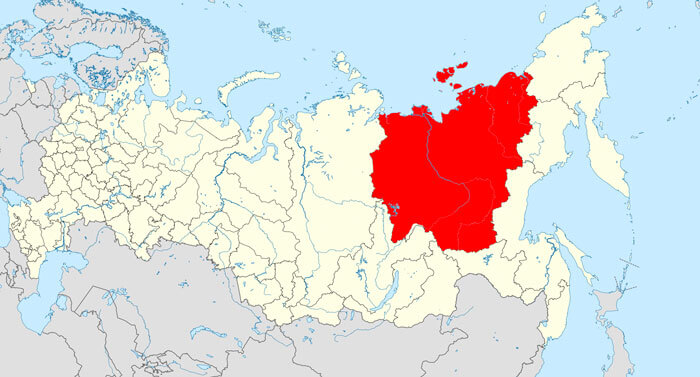 This is the answer to the question of which constituent entity of Russia is the largest. The Republic of Sakha is the largest constituent entity of the Russian Federation in terms of territory, which occupies 18.01% of the area of the Russian Federation, and is part of the Far Eastern Federal District.
This is the answer to the question of which constituent entity of Russia is the largest. The Republic of Sakha is the largest constituent entity of the Russian Federation in terms of territory, which occupies 18.01% of the area of the Russian Federation, and is part of the Far Eastern Federal District.
The republic stretches from the shores of the East Siberian Sea and the Laptev Sea to the Aldan Upland (2,000 km from north to south, 2,500 km from west to east). Compared with other countries in the world, the size of Yakutia is equal, for example, to five states such as Ukraine.
At the same time, the object is sparsely populated (958.29 thousand people) - the population density is 0.31 people / sq. km. This is mainly due to the mountainous relief and harsh natural conditions (a third of the territory lies beyond the Arctic Circle). In the famous Oymyakon there is a cold pole of the Northern Hemisphere with a recorded minimum temperature of -68 degrees Celsius.
The cultural heritage of the Yakuts, Evens and Evenks, the indigenous inhabitants of the republic, is carefully preserved here.
The region is unique in the volume and potential of natural resources: deposits of coal, hydrocarbons, gold, diamonds (25% of the world's production), uranium antimony, and other rare minerals have been found.

